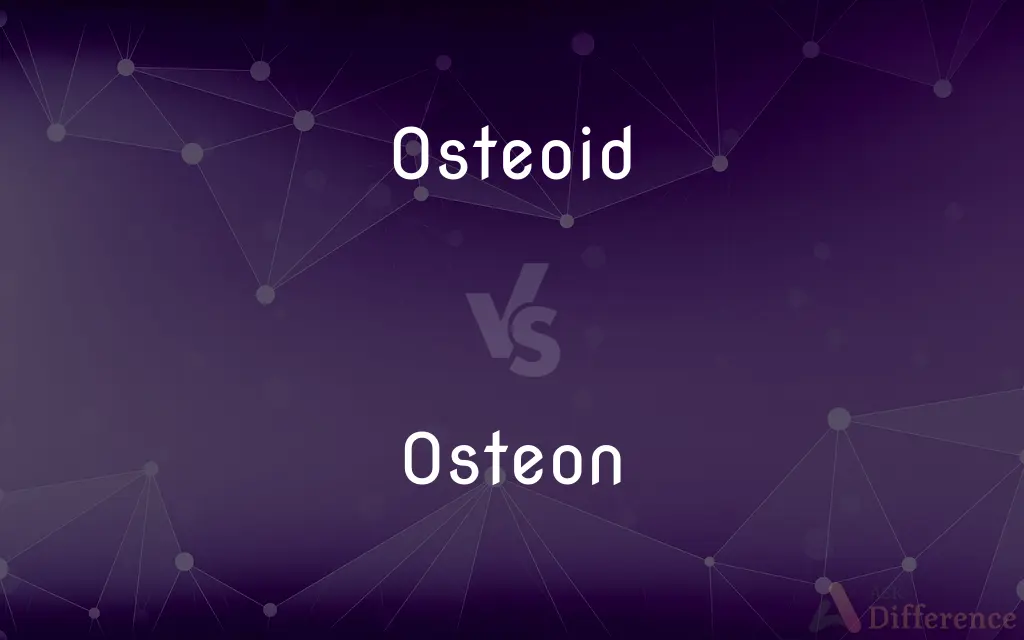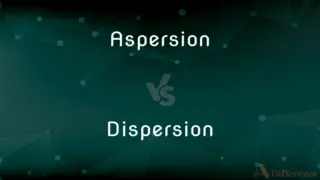Osteoid vs. Osteon — What's the Difference?
By Tayyaba Rehman — Updated on November 7, 2023
Osteoid is the unmineralized organic portion of the bone matrix, whereas an osteon is the structural unit of compact bone.

Difference Between Osteoid and Osteon
Table of Contents
ADVERTISEMENT
Key Differences
Osteoid and osteon are terms related to bone structure. Osteoid refers to the newly formed, unmineralized bone matrix consisting of collagen and ground substance. Osteon, on the other hand, is the cylindrical structure within the compact bone that contains the central canal and concentric lamellae of mineralized bone.
The osteoid serves as the framework for bone mineralization. It is produced by osteoblasts before it hardens into bone. Osteons, however, are the result of this mineralization, and are fully formed bone structures that facilitate the bone's blood supply and communication.
While osteoid makes up the initial bone substance that is yet to calcify, osteons are mature bone structures that have already undergone the calcification process. Osteons are also known as Haversian systems and are composed of multiple layers of mineralized matrix.
Osteoid's role is crucial in bone growth and healing as it is the precursor to hard bone. Osteons are critical in maintaining the bone's strength and integrity, with their design optimized for resisting stress and strains.
Osteoid can be found throughout the bone during its formation or repair, indicating active bone growth. Osteons are primarily found in the compact bone and are responsible for the bone's rigidity and strength.
ADVERTISEMENT
Comparison Chart
Definition
Unmineralized bone matrix
Structural unit of compact bone
Composition
Collagen and ground substance
Concentric lamellae of mineralized bone
Stage of Bone Development
Pre-calcification
Post-calcification, mature bone
Role in Bone
Framework for mineralization
Facilitates blood supply and withstands stress
Location
Throughout the bone during growth and repair
Primarily in compact bone
Compare with Definitions
Osteoid
Precursor to bone
The osteoid gradually hardened into solid bone.
Osteon
Definitions and Examples for Osteon:
Osteoid
Collagen-rich matrix
Osteoid is rich in collagen, which provides flexibility.
Osteon
Fundamental bone unit
An osteon is the basic structural unit of compact bone.
Osteoid
Definitions and Examples for Osteoid:
Osteon
Comprised of lamellae
The concentric lamellae in an osteon are like rings in a tree.
Osteoid
Unmineralized tissue
Osteoid must undergo mineralization to become functional bone.
Osteon
Contains blood vessels
Each osteon has a central canal for blood vessels.
Osteoid
Initial bone substance
The surgeon noted the presence of osteoid at the fracture site.
Osteon
Cylindrical structures
Osteons are arranged in cylinders to provide bone strength.
Osteoid
Organic part of the bone
Osteoid forms before the inorganic components of bone.
Osteon
Bone's communication system
Osteons facilitate nutrient and waste transport in bone.
Osteoid
In histology, osteoid is the unmineralized, organic portion of the bone matrix that forms prior to the maturation of bone tissue. Osteoblasts begin the process of forming bone tissue by secreting the osteoid as several specific proteins.
Osteon
The osteon or haversian system (named for Clopton Havers) is the fundamental functional unit of much compact bone. Osteons are roughly cylindrical structures that are typically between 0.25 mm and 0.35 mm in diameter.
Osteoid
Resembling bone.
Osteon
A structural unit of bone consisting of a haversian canal and corresponding lamellae of compact bone. Also called haversian system.
Osteoid
The bone matrix, especially before calcification.
Osteon
(anatomy) Any of the central canals, and surrounding bony layers, found in compact bone.
Osteoid
Of, pertaining to, or characteristic of bone; bonelike
Osteoid
An organic matrix of protein and polysaccharides, secreted by osteoblasts, that becomes bone after mineralization
Osteoid
Resembling bone; bonelike.
Common Curiosities
How many osteons are in a bone?
The number varies, but compact bone is densely packed with osteons.
Are osteoids visible under a microscope?
Yes, osteoids are visible as the unmineralized portion of bone tissue.
What cells produce osteoid?
Osteoblasts are responsible for producing osteoid.
What is osteoid?
Osteoid is the organic, non-mineralized component of bone matrix.
Are osteons found in all types of bone?
Osteons are primarily found in compact bone.
What is the function of osteoid?
The function of osteoid is to serve as a scaffold for mineral deposition.
Can osteoid be found in mature bone?
Osteoid is present in mature bone but only as the newly formed layer.
What does an osteon consist of?
An osteon consists of concentric lamellae around a central canal.
Do osteons repair themselves?
Yes, osteons can be remodeled in response to stress or damage.
Can osteoid become an osteon?
Yes, osteoid becomes an osteon after mineralization.
Do all bones have osteoids?
Osteoids are present during bone formation or repair in all bones.
What happens to osteoid in osteoporosis?
In osteoporosis, the mineralization of osteoid can be disrupted.
Is the central canal in every osteon?
Yes, each osteon has a central canal containing blood vessels.
Is the size of an osteon constant?
Generally, yes, but the size can vary slightly between individuals.
How does an osteon contribute to bone health?
Osteons provide structural integrity and facilitate vascular and nerve supply.
Share Your Discovery

Previous Comparison
Aspersion vs. Dispersion
Next Comparison
Sendoff vs. FarewellAuthor Spotlight
Written by
Tayyaba RehmanTayyaba Rehman is a distinguished writer, currently serving as a primary contributor to askdifference.com. As a researcher in semantics and etymology, Tayyaba's passion for the complexity of languages and their distinctions has found a perfect home on the platform. Tayyaba delves into the intricacies of language, distinguishing between commonly confused words and phrases, thereby providing clarity for readers worldwide.














































